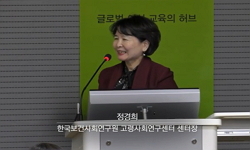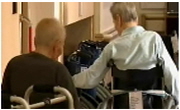Germany’s nursing care system was introduced as a social insurance system in January 1995, and the legal basis is Part 1 of the Social Code. Nursing care insurance is divided into public care insurance (soziale Pflegeversicherung) and private care i...
http://chineseinput.net/에서 pinyin(병음)방식으로 중국어를 변환할 수 있습니다.
변환된 중국어를 복사하여 사용하시면 됩니다.
- 中文 을 입력하시려면 zhongwen을 입력하시고 space를누르시면됩니다.
- 北京 을 입력하시려면 beijing을 입력하시고 space를 누르시면 됩니다.

독일 간병보험제도에서 간병인 지원에 관한 고찰 = A Study on Support for Caregivers in the German Nursing Insurance System
한글로보기https://www.riss.kr/link?id=A108376829
-
저자
정순형 (광주여자대학교)
- 발행기관
- 학술지명
- 권호사항
-
발행연도
2022
-
작성언어
Korean
-
주제어
Nursing insurance ; medical care benefits ; aging ; public health care ; medical care grade ; living support. ; 간병보험 ; 요양급여 ; 고령화 ; 공적의료 ; 요양등급 ; 생활지원.
-
등재정보
KCI등재
-
자료형태
학술저널
-
수록면
253-276(24쪽)
- 제공처
-
0
상세조회 -
0
다운로드
부가정보
다국어 초록 (Multilingual Abstract)
In Germany, since the 1970s, discussions have been taking place on nursing care measures. In the background of the introduction of nursing care insurance, if a person in need of nursing cannot bear the cost of care on his own, he has no choice but to rely on social assistance that corresponds to the livelihood protection of Korea. The increased burden is cited.
According to the Nursing Reinforcement Act of 2015, the insurance premium rate was increased, and at the same time, the Pflegevorsorgefonds was established under the Act to secure financial resources to prepare for further aging in the future. According to the Nursing Care Reform Act of 2017, the duties required for nursing and nursing jobs have also changed with the advent of an aging society and structural changes in diseases. In addition, in 2017, the Nursing Enhancement Act of the reform of the long-term care insurance system follows the existing level of care (Pflegestufe). In the nursing stage, the accreditation classification and standards were reviewed into 5 stages according to the nursing grade. According to the Act, all residents in need of nursing care were equally eligible for any physical, mental or psychological disability. In addition, for the purpose of supporting living at home, the level of care is newly recognized for those who have a slight disability in daily life. As a result, the number of beneficiaries of long-term care insurance increased, and among them, the number of beneficiaries of residential services increased by about 50% in public care insurance and about 20% in private care insurance. The biggest problem facing the German care insurance system for carers today is the lack of financial resources.
Germany’s nursing care system was introduced as a social insurance system in January 1995, and the legal basis is Part 1 of the Social Code. Nursing care insurance is divided into public care insurance (soziale Pflegeversicherung) and private care insurance (private Pflegeversicherung), both of which have insurance systems. The insurers of long-term care insurance are Pflegekasse and private insurance companies, which are based on Krankenkasse are subscribed. There is no age limit for nursing care insurance subscription and benefit conditions. You can receive nursing care insurance services if you have passed an accreditation survey and received a nursing grade (Pflegegrad). The public care insurance stipulates that the use of housing services and the use of support facilities for caregivers such as families take precedence over the use of services. Also, Germany’s public nursing insurance is called partial insurance and does not cover all the expenses required for nursing. The person in need of nursing care or his/her family shall bear the insufficient expenses. The insurer of public nursing insurance is the nursing home, and there is the sickness bank, which is the insurer of the public health insurance, to operate the nursing safe. Unlike Part VII of the Social Code, and Part V of the Social Code, the National Health Insurance Fund is a legally independent organization, but is organizationally under the umbrella of the Disease Safety Fund. In addition, the National Federation of Disease Vaults is also located in the National Federation of Nursing Vaults.
In Germany, since the 1970s, discussions have been taking place on nursing care measures. In the background of the introduction of nursing care insurance, if a person in need of nursing cannot bear the cost of care on his own, he has no choice but to rely on social assistance that corresponds to the livelihood protection of Korea. The increased burden is cited.
According to the Nursing Reinforcement Act of 2015, the insurance premium rate was increased, and at the same time, the Pflegevorsorgefonds was established under the Act to secure financial resources to prepare for further aging in the future. According to the Nursing Care Reform Act of 2017, the duties required for nursing and nursing jobs have also changed with the advent of an aging society and structural changes in diseases. In addition, in 2017, the Nursing Enhancement Act of the reform of the long-term care insurance system follows the existing level of care (Pflegestufe). In the nursing stage, the accreditation classification and standards were reviewed into 5 stages according to the nursing grade. According to the Act, all residents in need of nursing care were equally eligible for any physical, mental or psychological disability. In addition, for the purpose of supporting living at home, the level of care is newly recognized for those who have a slight disability in daily life. As a result, the number of beneficiaries of long-term care insurance increased, and among them, the number of beneficiaries of residential services increased by about 50% in public care insurance and about 20% in private care insurance. The biggest problem facing the German care insurance system for carers today is the lack of financial resources.
국문 초록 (Abstract)
공적 간병보험에서는 주택 서비스의 이용 및 가족 등의 간병인 지원 시설 서비스의 이용보다 우선시킨다고 규정한다. 또, 독일의 공적 간병보험은 부분보험으로 불리고 있으며, 간호에 필요한 모든 비용을 감당하지 않는다. 부족할 비용에 대해서는 간호가 필요한 본인이나 그 가족이 부담한다.
공적 간호보험의 보험자는 간병금고인데, 간호금고 운영은 공적 의료보험의 보험자인 질병금고가 있다. 간병금고는 사회법전 Ⅺ편, 질병금고는 사회법전 Ⅴ편과 근거법이 달리, 간병금고는 법적으로 독립된 조직인 반면, 조직상은 질병금고의 산하에 있다. 또, 질병금고 중앙연합회는 간호금고 중앙연합회에도 자리 잡고 있다.
독일에서는 1970년대부터 간병대책 논의가 이뤄지고 있었다. 간병보험이 도입된 배경에는 간호를 필요로 하는 사람 스스로는 간병비용을 부담할 수 없는 경우, 한국의 생활보호에 해당하는 사회부조에 의존할 수밖에 없고, 이러한 사람이 증대한 결과로서, 지자체의 재정부담이 증가한 것 등이 꼽힌다.
2015년의 간병강화법에서는 보험료율이 인상됨과 동시에 동법에 의해 간병준비기금(Pflegevorsorgefonds)이 설립되어 장래의 추가적인 고령화에 대비한 재원이 확보되었다. 2017년 간병직 개혁법에서는 초고령사회의 도래와 질병의 구조변화에 따라 간호직이나 간병직에 요구되는 업무도 바뀌었기 때문에 기존에 별도로 수행되던 간호사(Gesundheits-und Krankenpfleger)와 간병인의 교육이 통일되었다. 또한 2017년의 요양보험제도 개혁의 요양강화법에서는 기존의 요양등급(Pflegestufe)에 따른다. 요양단계에서 간호등급에 따른 5단계로 인정구분과 기준을 재검토했다. 동법에 따라 간병을 필요로 하는 모든 주민은 신체적, 정신적 또는 심리적 어느 장애라도 평등하게 수급 대상이 되었다. 또, 자택에서의 생활지원을 목적으로 일상생활을 하는데 약간의 장애가 있는 사람에게는 새롭게 간병등급이 인정되게 되었다. 그 결과 요양보험의 수급자 수가 증가하였고, 그 중에서도 거택 서비스의 수급자 수는 공적 간병보험에서 약 50%, 민간 간병보험에서 약 20% 증가했다. 오늘날 독일 간병보험제도가 직면한 간병인 지원에 대해 가장 큰 문제는 재원의 부족이다.
독일의 간병제도는 1995년 1월에 사회보험제도로 도입되었으며, 근거법은 사회법전 제1편이다. 간병보험은 공적 간병보험(soziale Pflegeversicherung)과 민간 간병보험(private Pflegeversicherung)으로 나...
독일의 간병제도는 1995년 1월에 사회보험제도로 도입되었으며, 근거법은 사회법전 제1편이다. 간병보험은 공적 간병보험(soziale Pflegeversicherung)과 민간 간병보험(private Pflegeversicherung)으로 나누어져 있으며, 양자를 아울러 모두 보험제도가 성립되어 있다. 요양보험의 보험자는 질병금고(Krankenkasse)를 모체로 하는 요양금고(Pflegekasse) 및 민간보험회사이며, 공적 요양보험에는 공적의료보험(GKV) 가입자, 민간 요양보험에는 민간의료보험(private Krankenversicherung) 가입자가 가입되어 있다. 간병보험 가입 및 급여조건에 나이 제한은 없다. 인정조사를 거쳐서 간병등급(Pflegegrad)이 인정된 경우에 간병보험 서비스를 수급할 수 있다.
공적 간병보험에서는 주택 서비스의 이용 및 가족 등의 간병인 지원 시설 서비스의 이용보다 우선시킨다고 규정한다. 또, 독일의 공적 간병보험은 부분보험으로 불리고 있으며, 간호에 필요한 모든 비용을 감당하지 않는다. 부족할 비용에 대해서는 간호가 필요한 본인이나 그 가족이 부담한다.
공적 간호보험의 보험자는 간병금고인데, 간호금고 운영은 공적 의료보험의 보험자인 질병금고가 있다. 간병금고는 사회법전 Ⅺ편, 질병금고는 사회법전 Ⅴ편과 근거법이 달리, 간병금고는 법적으로 독립된 조직인 반면, 조직상은 질병금고의 산하에 있다. 또, 질병금고 중앙연합회는 간호금고 중앙연합회에도 자리 잡고 있다.
독일에서는 1970년대부터 간병대책 논의가 이뤄지고 있었다. 간병보험이 도입된 배경에는 간호를 필요로 하는 사람 스스로는 간병비용을 부담할 수 없는 경우, 한국의 생활보호에 해당하는 사회부조에 의존할 수밖에 없고, 이러한 사람이 증대한 결과로서, 지자체의 재정부담이 증가한 것 등이 꼽힌다.
2015년의 간병강화법에서는 보험료율이 인상됨과 동시에 동법에 의해 간병준비기금(Pflegevorsorgefonds)이 설립되어 장래의 추가적인 고령화에 대비한 재원이 확보되었다. 2017년 간병직 개혁법에서는 초고령사회의 도래와 질병의 구조변화에 따라 간호직이나 간병직에 요구되는 업무도 바뀌었기 때문에 기존에 별도로 수행되던 간호사(Gesundheits-und Krankenpfleger)와 간병인의 교육이 통일되었다. 또한 2017년의 요양보험제도 개혁의 요양강화법에서는 기존의 요양등급(Pflegestufe)에 따른다. 요양단계에서 간호등급에 따른 5단계로 인정구분과 기준을 재검토했다. 동법에 따라 간병을 필요로 하는 모든 주민은 신체적, 정신적 또는 심리적 어느 장애라도 평등하게 수급 대상이 되었다. 또, 자택에서의 생활지원을 목적으로 일상생활을 하는데 약간의 장애가 있는 사람에게는 새롭게 간병등급이 인정되게 되었다. 그 결과 요양보험의 수급자 수가 증가하였고, 그 중에서도 거택 서비스의 수급자 수는 공적 간병보험에서 약 50%, 민간 간병보험에서 약 20% 증가했다. 오늘날 독일 간병보험제도가 직면한 간병인 지원에 대해 가장 큰 문제는 재원의 부족이다.
참고문헌 (Reference)
1 박복희 ; 전희주, "제3보험의 가입 요인: 간병보험을 중심으로" 한국리스크관리학회 29 (29): 77-106, 2018
2 장소영, "장기간병보험(長期看病保險)의 언더라이팅" 한국생명보험의학회 58-68, 2004
3 이한덕 ; 박홍민, "보험회사의 간병시장 진출전략" 한국보험학회 65 : 93-120, 2003
4 김창보, "병원간병 서비스의 건강보험 급여화 방안" 9-21, 2010
5 정혜윤 ; 한유진, "노인장기요양보험의 지출과 장기요양시설 이용에 대한 결정요인 분석" 한국보건경제정책학회 27 (27): 73-94, 2021
6 최령 ; 황병덕, "간병인의 간병교육 현황 및 간병제도 법제화 인식" 한국통합사례관리학회 (13) : 1-19, 2014
7 마정락 ; 박광수, "간병위험 헤지를 위한 민영간병보험에 관한 연구- 부산지역 보험설계사의 설문조사를 중심으로" 한국FP학회 7 (7): 25-43, 2014
8 이진숙, "가족내 간병과 간병보험의 복지정책적 함의" 한국인구학회 24 (24): 183-202, 2001
9 本沢巳代子, "高齢者・障害者の権利擁護と介護保険 ドイツの世話制度と介護保険の実際を参考として" (14) : 143-, 1999
10 倉田聡, "福祉サ一ビス契約の法的研究" 信山社 72-, 2007
1 박복희 ; 전희주, "제3보험의 가입 요인: 간병보험을 중심으로" 한국리스크관리학회 29 (29): 77-106, 2018
2 장소영, "장기간병보험(長期看病保險)의 언더라이팅" 한국생명보험의학회 58-68, 2004
3 이한덕 ; 박홍민, "보험회사의 간병시장 진출전략" 한국보험학회 65 : 93-120, 2003
4 김창보, "병원간병 서비스의 건강보험 급여화 방안" 9-21, 2010
5 정혜윤 ; 한유진, "노인장기요양보험의 지출과 장기요양시설 이용에 대한 결정요인 분석" 한국보건경제정책학회 27 (27): 73-94, 2021
6 최령 ; 황병덕, "간병인의 간병교육 현황 및 간병제도 법제화 인식" 한국통합사례관리학회 (13) : 1-19, 2014
7 마정락 ; 박광수, "간병위험 헤지를 위한 민영간병보험에 관한 연구- 부산지역 보험설계사의 설문조사를 중심으로" 한국FP학회 7 (7): 25-43, 2014
8 이진숙, "가족내 간병과 간병보험의 복지정책적 함의" 한국인구학회 24 (24): 183-202, 2001
9 本沢巳代子, "高齢者・障害者の権利擁護と介護保険 ドイツの世話制度と介護保険の実際を参考として" (14) : 143-, 1999
10 倉田聡, "福祉サ一ビス契約の法的研究" 信山社 72-, 2007
11 田中耕太郎, "介護手当(金銭給付)の意義,実施状況およびその評価" (131) : 24-, 2000
12 エルケ・モ一ア医学博士講演会資料, "介護保険転換期 新制度のしくみとドイツ制度の現状" 145-, 2005
13 増田雅暢, "世界の介護保障" 法律文化社 2014
14 本沢巳代子, "ㅂ公的介護保険 ドイツの先例に学ぶ" 日本評論社 1996
15 森周子, "メルケル政権下の介護保険制度改革の動向" (186) : 28-, 2014
16 丸山絵美子, "ホ一ム契約に対する規制と契約法の一般理論・社会福祉サ一ビス制度との関係現行ドイツホ一ム法との比較を通じて" (93) : 108-, 2006
17 松本勝明, "ドイツ社会保障論Ⅲ 介護保険" 信山社 69-, 2010
18 小西啓文, "ドイツ介護保険法における権利擁護システムの展開 介護相談員を例として" 119 : 707-, 2012
19 川久保寛, "ドイツ介護保険制度における保険料率法定の意義" (30) : 159-, 2015
20 土田武史, "ドイツ介護保険の現金給付" (1879) : 46-, 1996
21 本沢巳代子, "ドイツの介護保障制度とその課題" (193) : 49-, 2000
22 土田武史, "ドイツの介護保険法" 13 (13): 6-, 1995
23 田中謙一, "ドイツの2008 年介護改革①" (2509) : 53-, 2008
24 田中謙一, "ドイツの2007 年医療改革(3)" (2438) : 52-, 2007
25 木下秀雄, "ドイツにおける介護保険と介護扶助" (131) : 14-, 2000
26 斎藤義彦, "ドイツと日本‘介護’の力と危機" ミネルヴァ書房 82-, 2012
27 이주노, "‘보호자 없는 병원’ 시범사업과 제도화 어떻게 할 것인가: 간호, 간병인력 확충과 개인간병 부담의 사회적 해결 계기되어야" 59-64, 2010
28 Heinz Rothgang, "Theorie und Empirie der Pflegeversicherung" S.295-, 2009
29 Peter Pick, "Reform der Pflegeversicherung –Auswirkungen auf die Pflegebedürftigen und die Pflegepersonen" S.62-, 2007
30 Theresia Degener, "Das ambulante Pflegerechtsverhältnis als Modell eines Sozialrechtsverhältnisses"
31 "BT-Drucks, 16/7439. S.1"
32 "BT-Drucks, 12/5262, S.112"
33 "BT-Drucks, 10/1943. S.5. Tabelle 3"
동일학술지(권/호) 다른 논문
-
가사근로자의 고용개선 등에 관한 법률의 주요 내용과 실효성의 검토
- 사단법인 한국법이론실무학회
- 오호철
- 2022
- KCI등재
-
- 사단법인 한국법이론실무학회
- 노호창
- 2022
- KCI등재
-
공공조달 조달법제의 현황과 감사제도 - 비교법적 검토를 중심으로 -
- 사단법인 한국법이론실무학회
- 권수진
- 2022
- KCI등재
-
- 사단법인 한국법이론실무학회
- 김영국
- 2022
- KCI등재




 DBpia
DBpia






